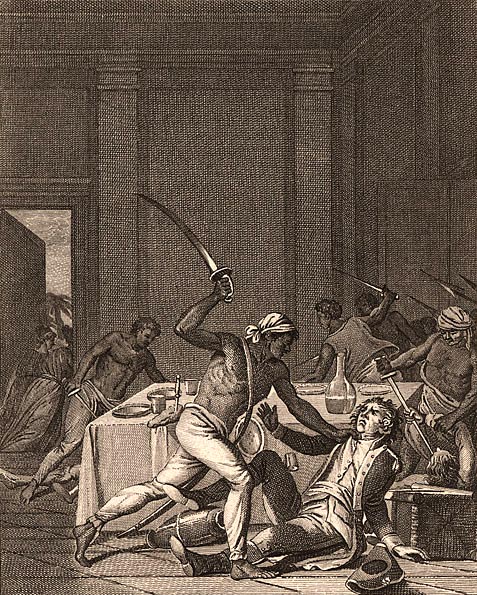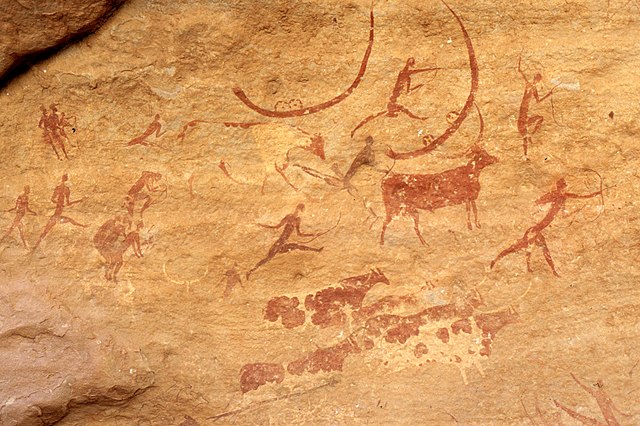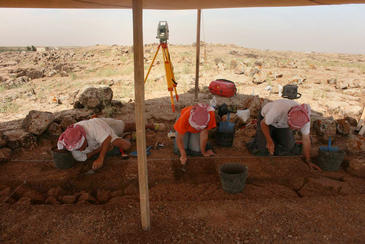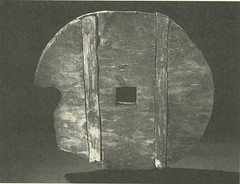John Hawks published today an interesting albeit potentially misleading exercise of comparing (known) Neanderthal DNA (Vi33.16) to moder humans by HGDP samples.
The first graphic is a for example a very visual representation of why geneticists have concluded that there is a percentage of Neanderthal admixture in non-African humans, a striking visual synthesis of the results of
Green 2010 with other modern samples:
It is easy to see for all in this graph that if the median shared Neanderthal variants in Africans is c. 626,000, while in Eurasians is c. 644,000 (visual estimates), then there is something going on and admixture is the most likely explanation.
A simple cross-multiplication exercise shows that the admixture apportion using these medians would be c. 2.9%. However a cautionary use of a higher figure among the African variability range (likely not caused by admixture but retained ancestral diversity) such as 630,000 yields 2.2%.
Green 2010 and later reanalysis by the NGP team estimated 2.4% (although they initially talked of 1-4%), all of which illustrates how is not easy to come with an exact percentage figure and that some uncertainty remains and must remain by the very nature of the exercise and the samples involved.
Splitting hairs
But of course we love to split hairs, at least a bit. I must admit
I did it myself back in the day with the handful of samples used by Green et al. originally. Then I was asking rhetorically:
are Chinese slightly "more Neanderthal" than other Eurasians?
Not quite because of the uncertainty implied in all the comparison is the real answer: the apparent differences are too small to be significant.
And this more or less what Hawks ponders in his article. As you can see above Europeans appear now slightly more Neanderthal than East Asians. However the difference is actually trivial: approx. 1000 base pairs, what is a variance of 0.12 percentile points of that approx. 2.4% (Hawks writes 'half-percent' when talking of intra-European differences of the same range, but he must be measuring something else than I am: 0.005x2.4%=0.012%, maybe he meant 5%... of that 2.4%? Unsure and, as he does not allow comments, I can't ask).
However, in spite of formally acknowledging this insignificance of the differences, he goes on to state the following unlikely hypothesis:
At present, we can take as a hypothesis that Europeans have more Neandertal ancestry than Asians. If this is true, we can further guess that Europeans may have mixed with Neandertals as they moved into Europe, constituting a second process of population mixture beyond that shared by European and Asian ancestors.
While it's not absolutely impossible, the data does not support any meaningful extra admixture in Europeans but actually what it does support is the lack of any significative difference through Eurasia. IF there was any extra admixture in Europe (or better West Eurasia, what's the obsession with Europe?) it is not detectable and hence was surely hyper-minimal.
We are therefore before yet another case of wishful thinking, of which I have stumbled upon several, much more severe cases in the las weeks alone. The illusion of a Neanderthal admixture or assimilation or even full continuity into, specifically, modern Europeans (usually West Asia is totally ignored even if it was there where most of the Sapiens-Neanderthal interaction must have taken place) is an obsession difficult to put aside for some I am learning.
Hawks is still quite serious and scientific and knows the ropes of genetics quite a bit and, therefore, he does not insist on that too much, showing different angles and comparisons that are interesting albeit unsupportive of his outlined hypothesis. However he does not abandon that unlikely boat so obviously sinking.
I am realizing that it is much harder for some Eurocentric multiregionalists to abandon their old Neanderthalist hypothesis than I would have expected. After all the genetic data is there for all to see and I must say that Hawks provides us with highly informative eye-candy here, which clearly supports the Neanderthal admixture episode and the uniformity of it across the various Eurasian populations.
Yet he seems blinded by the C.I. variation, which is caused, no doubt, mostly or only by local founder effects and/or drift (after the Neanderthal admixture episode).
Illusion of African Neanderthal admixture
A good example is again provided by Hawks himself:
Yorubas here appear some 2000-3000 BPs more Neanderthal than Luhyas. Even Hawks admits to be puzzled by this result, which is obviously attributable to mere ancestral diversity within Homo sapiens (but not for him). He expected the opposite result: that Luhyas, who live in Kenya, would be more influenced by Eurasian back-flow into Africa and display some greater Neanderthal affinity.
Actually this comparison does not just illustrate well how such small ranges of variation are normal and a remnant of ancestral diversity within the species (most probably) but also illustrates how Dienekes' hypothesis about Neanderthal admixture being in fact internal structure of Homo Sapiens before the migration out of Africa (or even after, because he has also argued for a greater role for Arabia and what not) is a total fantasy.
Thanks for the interesting and beautiful graphs, Dr. Hawks, but I cannot agree with your hypothesis because I see zero support for it in your own data. I think you have a clear case of splitting hairs syndrome, probably a symptom of repressed multiregionalist grudge (Eurocentric Neanderthalist variant).































